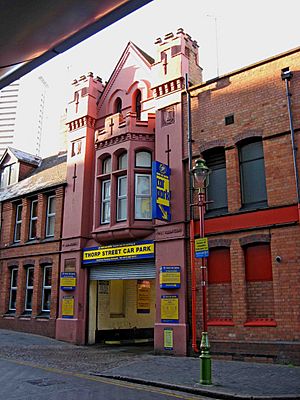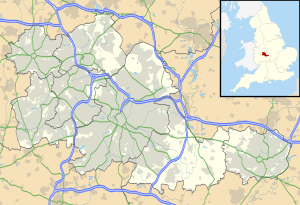Thorp Street drill hall, Birmingham facts for kids
Quick facts for kids Thorp Street drill hall |
|
|---|---|
| Birmingham | |

Thorp Street drill hall, Birmingham
|
|
|
Location within West Midlands
|
|
| Coordinates | 52°28′30″N 1°53′57″W / 52.47504°N 1.89911°W |
| Type | Drill hall |
| Site history | |
| Built | 1881 |
| Built for | War Office |
| In use | 1881- |
The Thorp Street drill hall was once a special building in Birmingham, England. It was used by soldiers for training and getting ready for duty. Think of it like a big gym and office for military groups!
Contents
History of the Drill Hall
Early Days and Design
This important building was finished in 1881. It was designed by an architect named Frank Barlow Osborn. The drill hall was built to be the main base for a group of soldiers called the 1st Volunteer Battalion, The Royal Warwickshire Regiment.
World War I and Changes
Over time, this soldier group changed. In 1891, it split into two parts, becoming the 1st and 2nd Battalions of the Birmingham Rifles. Later, in 1908, these groups became the 5th and 6th Battalions of the Royal Warwickshire Regiment.
When World War I began in August 1914, both of these battalions gathered at the Thorp Street drill hall. From there, they were sent to fight on the Western Front. This was a major battle area in France and Belgium.
Becoming Anti-Aircraft Units
In 1936, the role of these soldier groups changed again. Both the 5th and 6th battalions became "anti-aircraft" units. This meant their job was to defend against enemy planes. The 5th battalion was renamed the 45th (The Royal Warwickshire Regiment) Anti-Aircraft Regiment. The 6th battalion became the 69th (The Royal Warwickshire Regiment) Anti-Aircraft Regiment. The 45th Regiment stayed at Thorp Street, but the 69th Regiment moved to a new place called Brandwood House in Kings Norton.
Later Years and Decommissioning
After World War II, the army reorganized. In 1947, a new group called 580 (The Royal Warwickshire Regiment) Light Anti-Aircraft Regiment Royal Artillery was formed at the Thorp Street drill hall. Later, in 1955, another group, 442 Light Anti-Aircraft Regiment, Royal Artillery, was also formed there.
However, in 1961, this regiment was broken up. The drill hall was then "decommissioned," which means it was no longer used by the military. Much of the building was taken down. Today, the front part of the old drill hall is now the entrance to a car park in a busy part of the city.


